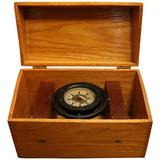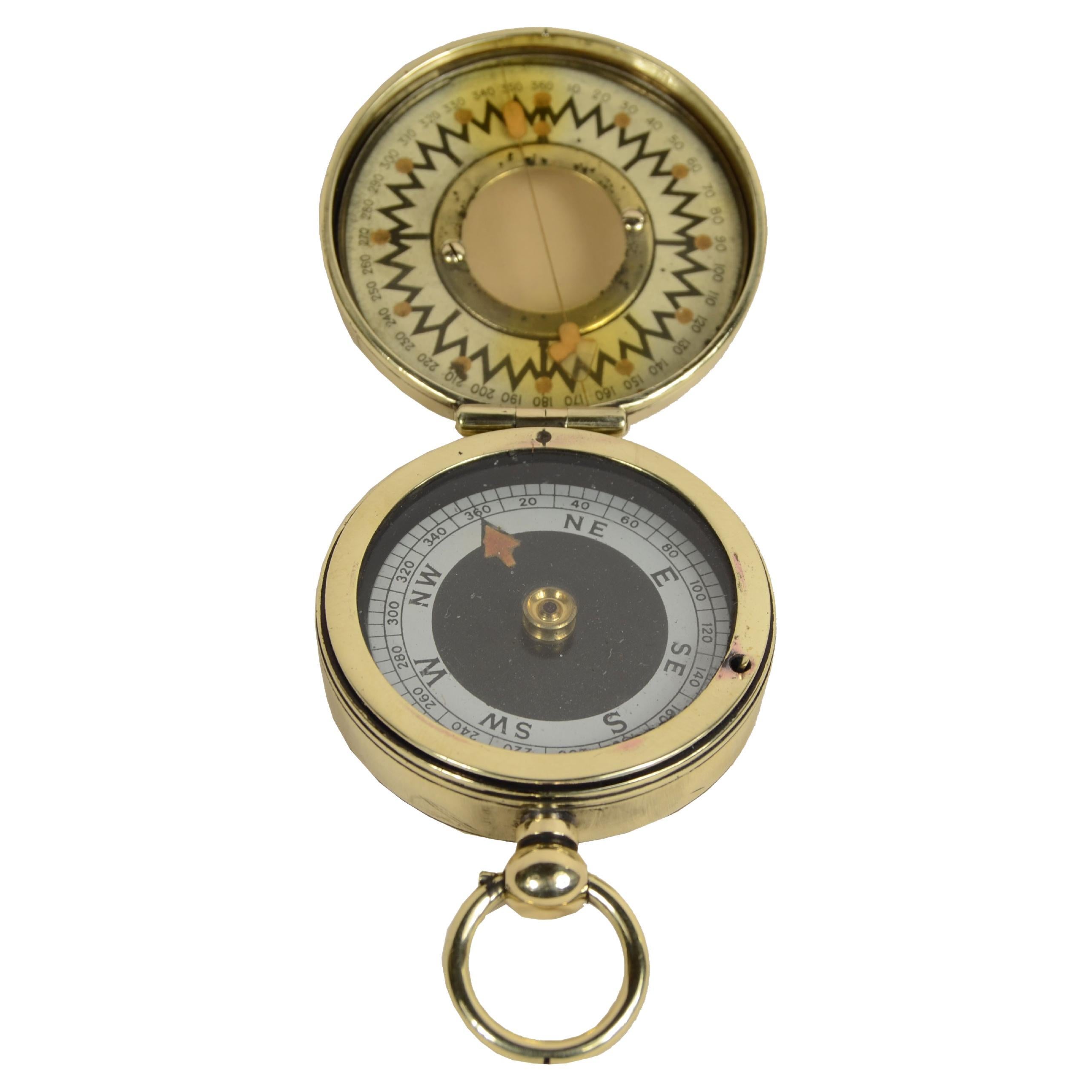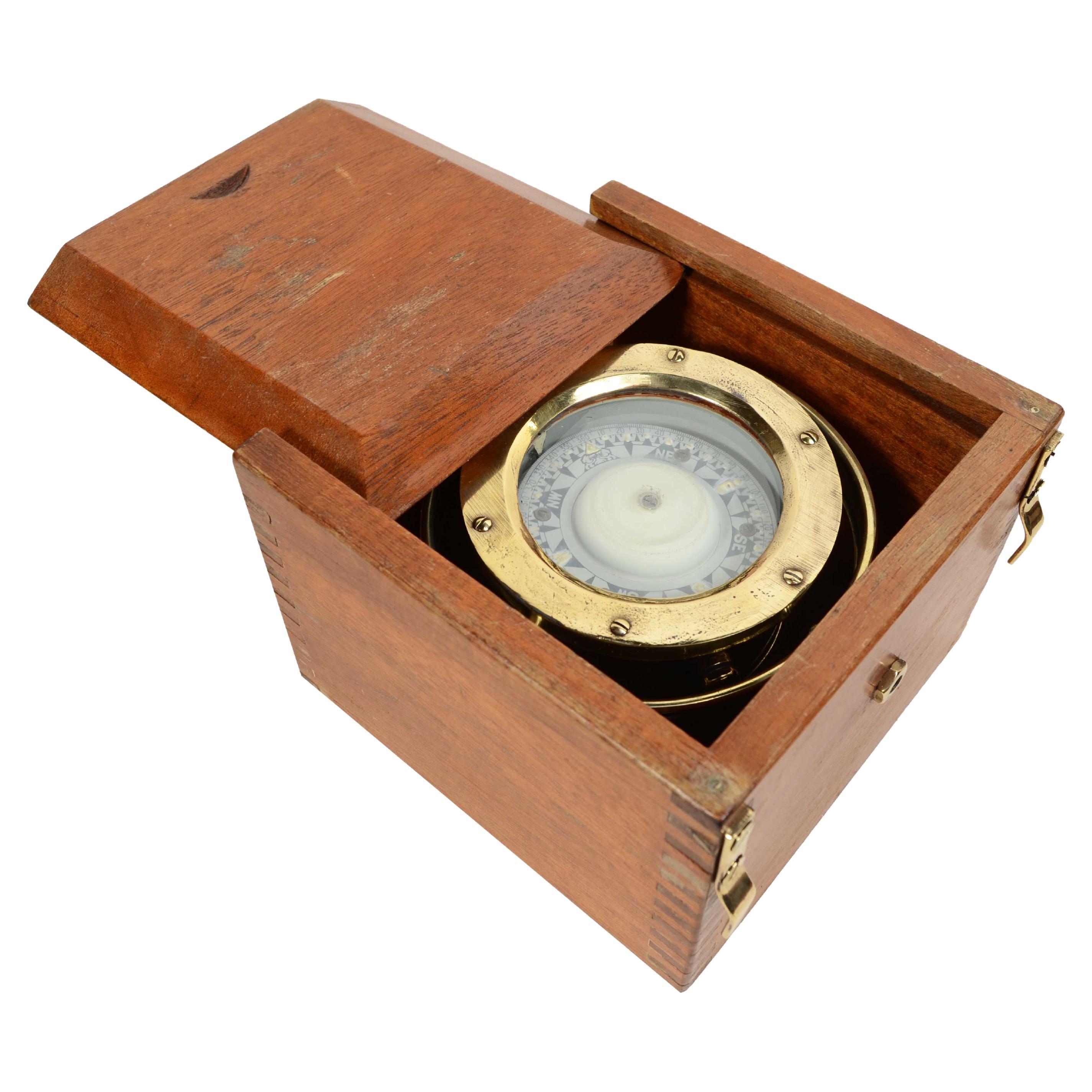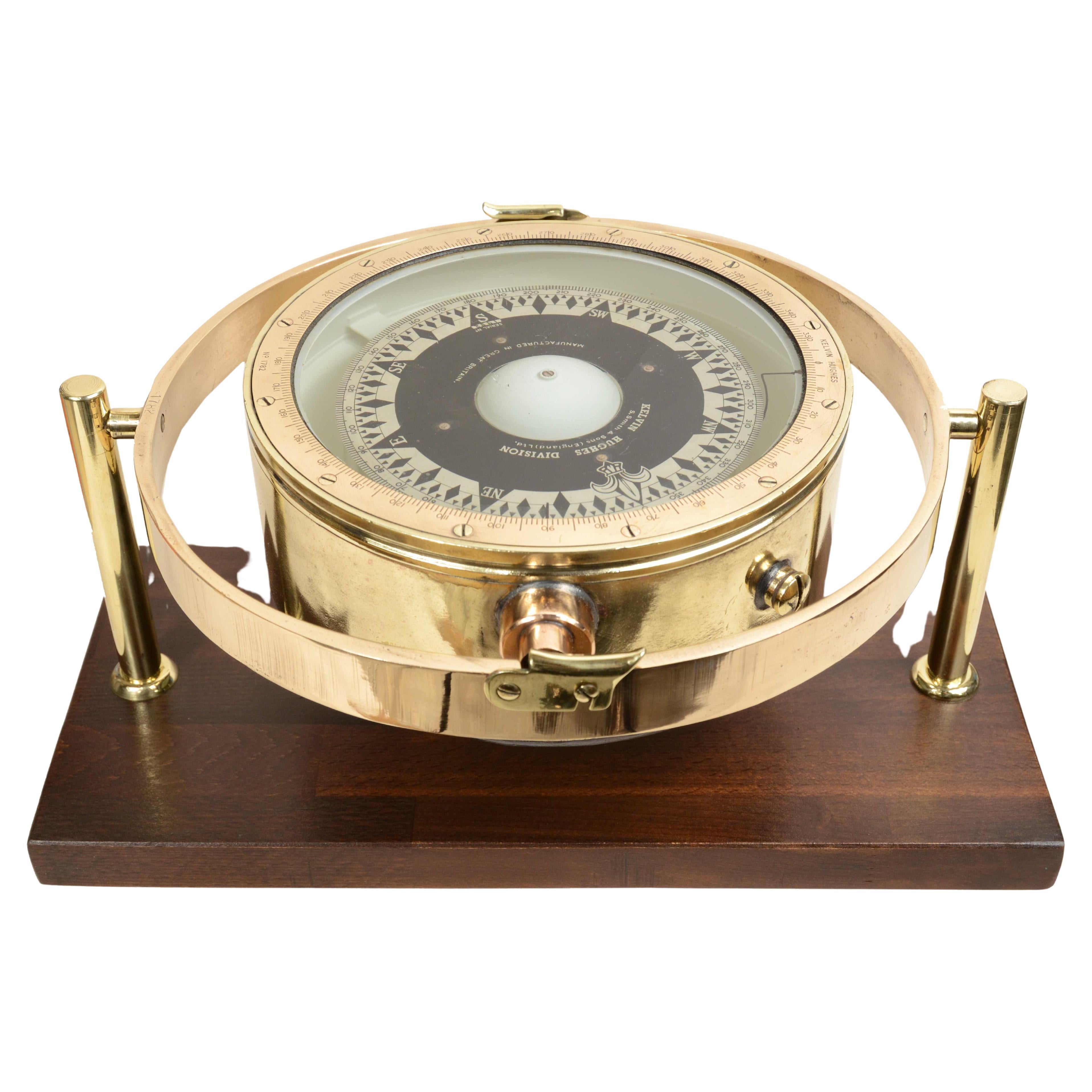Items Similar to Brass and copper nautical compass on cardan joint signed DIRIGO from 1920s
Want more images or videos?
Request additional images or videos from the seller
1 of 16
Brass and copper nautical compass on cardan joint signed DIRIGO from 1920s
About the Item
Brass and copper nautical compass on gimbals and housed in its original wooden box with brass lid closing hooks, signed Eugene M. Sherman Seattle U.S.A.Trade Dirigo Mark of the 1920s. The compass consists of a cylindrical-shaped copper vessel, to the bottom of which is fixed a hard metal stem, on which rests the eight-twenty rose complete with goniometric circle properly constrained. Box size cm 19.2x19x11.5 - inches 7.5x7.5x4.5 - compass diameter cm 13.5 - inches 5.35. Bon état.
Eugene M. Sherman born in Lexington in 1872 moved with his wife Alice in Bellevue in Washington state in 1911 opening a new business the Dirigo Compass Factory, "Dirigo" was the state motto of Maine, Eugene's home state, and translated to ""I direct."
While Eugene was making compasses and other navigational instruments, his wife Alice was in charge of Bellevue's music scene. Skilled violinist, taught , and organized concerts music throughout the Bellevue area. Eugene shared his wife's love of music and, after retiring and selling the compass factory in 1944, devoted his time to making violins. Neighbors often heard Eugene and Alice playing duets on the porch of their house, trying out new instruments.
The Greeks and the Romans were still unaware of the possibility of harnessing magnetic fields for orientation, while it seems that this possibility was already somewhat known to the Chinese: around 2600 B.C. Emperor Hoang-Ti was able to overcome Prince Tchi-Yeou in battle thanks to a "magic" chariot, the See-Nan (chariot pointing south). The emperor, thanks to this device, identified the enemy's escape route, despite the fact that the enemy had concealed it through a blanket of smoke: fixed on the chariot was a human-shaped wooden silhouette that rotated on itself and, with its arm outstretched, always pointed south (pointing south of course was also pointing north at the same time, but south was considered by the Chinese to be the most important cardinal point). The Chinese also used their discoveries related to magnetic fields as a form of entertainment and spectacle: they would throw magnetized arrows as if they were dice, and these would line up in a south-north direction as if by magic, which greatly impressed and amazed the spectators.
The first historical records of the use of magnetic directive force in Europe date back to the late sec. XII or early XIII and attribute the exploitation of the properties of the magnet to the Amalfitans. The gimbal made its first appearance around the middle of the sec. XVI. An exact description is given in the short compendium "De la esfera y de la arte de navegar," by Martin Cortés (1551), which gives precise guidelines for the construction of the compass. To the refinements of the instrument can largely be attributed the great discoveries of new lands, from the middle of the sec. XV onwards.
The last photo is the gift box.
- Dimensions:Height: 4.5 in (11.43 cm)Width: 7.4 in (18.8 cm)Depth: 7.5 in (19.05 cm)
- Materials and Techniques:
- Period:
- Date of Manufacture:1920
- Condition:Wear consistent with age and use.
- Seller Location:Milan, IT
- Reference Number:1stDibs: LU1020238877952
About the Seller
4.9
Platinum Seller
These expertly vetted sellers are 1stDibs' most experienced sellers and are rated highest by our customers.
Established in 1999
1stDibs seller since 2014
370 sales on 1stDibs
Typical response time: <1 hour
- ShippingRetrieving quote...Ships From: Milan, Italy
- Return PolicyA return for this item may be initiated within 14 days of delivery.
More From This SellerView All
- Brass nautical compass signed DIRIGO Eugen M. Sherman Seattle USA 1920Located in Milan, ITNautical compass on gimbal signed DIRIGO Eugen M. Sherman Seattle USA 1920s, mounted on custom-made walnut and brass board. Eight-twenty rose complete with protractor circle. The com...Category
Vintage 1920s Nautical Objects
MaterialsBrass
- Nautical survey compass The Magnapole Pat applied for Short & Mason 1920sLocated in Milan, ITBrass nautical voyage surveying compass circa 1920, signed The Magnapole Patend applied for Short & Mason Makers London; small compass used away from magnetic fields to verify ship's...Category
Vintage 1920s Nautical Objects
MaterialsBrass
- Brass nautical magnetic compass, signed Sestrel London circa 1870Located in Milan, ITBrass nautical magnetic compass, signed Sestrel London from the second half of the 19th century and housed in its original wooden box with slot lid, fitted with pins and handle bras...Category
Antique 1870s Nautical Objects
MaterialsBrass
- Large signed brass nautical magnetic compass KELVIN HUGHES DIVISION 1940Located in Milan, ITLarge brass and glass nautical magnetic compass, signed KELVIN HUGHES DIVISION S. Smith & Son (England) Ltd Manufactured in Great Britain circa 1940, mounted on custom-made wood an...Category
Vintage 1940s Nautical Objects
MaterialsBrass
- Boatswain's whistle in brass and copper English manufacture of the 1920sLocated in Milan, ITBoatswain's whistle made of brass and copper English manufacture of the 1920s, on the sides anchor. Length 13.x2.5x1.8 cm - inches 5.3x0.8x0.7. Good condition. This type of whistle i...Category
Vintage 1920s Nautical Objects
MaterialsBrass
- Large English nautical magnetic compass in brass and glass early 1900sLocated in Milan, ITLarge brass and glass nautical magnetic compass from the early 1900s, mounted on custom-made oak and brass board. Compass diameter cm 24.5 - inch 9.4, height with base cm 21 - inch 8...Category
Antique Early 1900s Nautical Objects
MaterialsBrass
You May Also Like
- Gimballed Brass Boat Compass by DirigoLocated in Norwell, MAGimballed brass boat compass by "Dirigo" of Seattle, Washington. With fleur-de-lis pointing north. Fitted to a birch box with lid. Circa 1975. Overall Dimensions: 5" H x 8" L x 8"...Category
Vintage 1970s American Nautical Objects
MaterialsBrass
- Boxed Compass by DirigoLocated in Norwell, MABoxed compass by Dirigo of Seattle. Alcohol filled card, alloy bezel, fitted to a unique custom box via gimbal, with hinged lid. Dimensions: 8 1/2" ...Category
20th Century Nautical Objects
- W. Hartmann Antique Oak & Copper Ships Binnacle Nautical Maritime CompassBy A. Lietz Co.Located in Dayton, OHLate 19th Century Ships Binnacle by W. Hartmann. Binnacles are an important navigation tool. They are often in the helm of the ship and allow sailor to maintain the correct course. This beautiful example has an octagonal case made from oak with brass fittings and removable copper dome...Category
Antique Late 19th Century Late Victorian Nautical Objects
MaterialsBrass, Copper
- Nautical Horn in Copper and Brass, 1960sLocated in Esbjerg, DKAn unusual long, lean and stylish maritime fog horn (presumably). It made from solid copper and has a brass mouthpiece. Manufactured in Scandinavia during the...Category
Vintage 1960s Scandinavian Scandinavian Modern Nautical Objects
MaterialsBrass, Copper
- T. Cooke London Brass Prismatic Nautical Maritime Navigation CompassBy T. Cooke & Sons Ltd.Located in Dayton, OHVintage T. Cooke of London prismatic compass. Brass case with pierced sight line in the lid, folding prism, metallic gold tone face, and short stand able to be screwed onto a tripod ...Category
Mid-20th Century Nautical Objects
MaterialsBrass
- T. Cooke London Brass Prismatic Nautical Navigation Compass with StandBy T. Cooke & Sons Ltd.Located in Dayton, OHVintage T. Cooke of London England prismatic compass. Brass case with mirrored lid interior, folding prism, metallic brass face, and short stand able to be screwed onto a tripod for ...Category
Mid-20th Century Nautical Objects
MaterialsBrass





